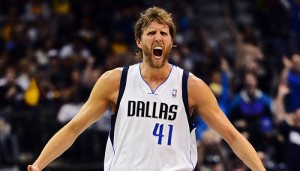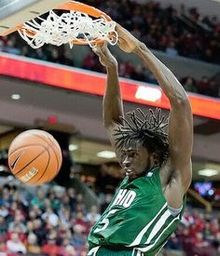 After a summer in which the Dallas Mavericks thought they found their franchise centerpiece, they now enter the season with an unfinished roster and a litany of question marks.
After a summer in which the Dallas Mavericks thought they found their franchise centerpiece, they now enter the season with an unfinished roster and a litany of question marks.
No more Monta Ellis. No more Tyson Chandler. No more Rajon Rondo.  Dallas will start three newcomers in the 2015-2016 season. And, after falling out of the top 10 in the NBA in 3-point percentage last season, Dallas focused all summer on adding floor spacers and succeeded.
Dallas will start three newcomers in the 2015-2016 season. And, after falling out of the top 10 in the NBA in 3-point percentage last season, Dallas focused all summer on adding floor spacers and succeeded.
Now, Rick Carlisle projects to start a lineup with four excellent shooters and a capable rebounder at center. If healthy, the offense has the talent and potential to be elite.
But without DeAndre Jordan – the one that got away – anchoring the defense, Dallas’ rim protection is suspect at best. Moreover, the team’s depth and durability already are in question. In a loaded Western Conference, there’s no margin for error. Can Carlisle take a roster full of other teams’ castoffs and transform them into contenders?
Here are five things to look for with the Mavericks this season.
1. Health concerns
In the NBA, durability is everything. Name a team in recent history that has won a championship with a key player injured. It is exceedingly rare. Unfortunately for Dallas, players with injury histories fill the depth chart.
Chandler Parsons, the team’s presumed face of the future, has still not been fully cleared for training camp after offseason knee surgery. Parsons underwent surgery on May 1 and unfortunate news out of Dallas this week suggests that the surgery was more serious than initially reported. While Parsons is determined to play in the season opener on Oct. 28, it may be in the team’s best interest to ease him back slowly. 
Wes Matthews, the team’s highest profile free agent signing this summer, also is questionable for the season opener – as expected. Matthews’ 2014-2015 season ended prematurely as he tore his left Achilles tendon in March, just as his then-Portland teammates were gearing up for a serious playoff run. Matthews has been one of the NBA’s elite 3-and-D players for the past several seasons, and Dallas gave him a $70 million contract under the assumption he can return to full strength.
Still, the Achilles tear is known as one of the most difficult injuries for a player to return from. While Matthews’ heart and determination need no questioning, it remains to be seen whether his post-injury form will warrant $70 million.
RELATED: Mavericks salaries and analysis
Carlisle tried to squash any rumors of Matthews seeing the floor in the season opener on Media Day, saying his starting shooting guard wouldn’t be ready to go. “He’s not going to want to tell you that and we’re going to have to fight to keep him off the court, but we’ve got to do this the right way,” the coach said. Still, Matthews has refused to concede and will continue to push himself into playing shape.
This is a a Texas-sized if, but if both these players return to full strength early in the season, Dallas could be a legitimate contender.
2. Deron Williams 3.0?
In one of the more shocking developments of the offseason, Deron Williams agreed to a buyout with the Brooklyn Nets worth $27.4 million, helping the Nets evade the luxury tax while clearing the way for the much-maligned Williams to return to his hometown team. 
Williams is not the perennial All-Star he once was and is coming off the worst season since his rookie campaign. He averaged just 13.3 points and 6.6 assists on a career-low 39 percent from the field for a team that finished under .500 in the Eastern Conference. Still, Williams had his games where he looks like his former self, like the 35-point outburst he had in the playoffs against Atlanta last season.
In Carlisle’s system in Dallas, Williams figures to be an immediate upgrade over Rajon Rondo. For starters, Williams, unlike Rondo, is a comfortable shooter from the perimeter. His passing skills and handles should create openings and mismatches for the up-tempo offense.
While the Mavericks will eventually try to ease Parsons into a facilitating role within the offense, Williams’ smarts and off-ball skills will enable him to play off the ball effectively – something both Ellis and Rondo struggled with.
3. How much does Dirk Nowitzki have left in the tank?
 Dirk Nowitzki has cemented his legacy as one of the 20 greatest players in NBA history. Last postseason, however, the Houston Rockets exploited Nowitzki’s weak legs and limited jumping ability to completely dominate the Mavericks via the alley-oop.
Dirk Nowitzki has cemented his legacy as one of the 20 greatest players in NBA history. Last postseason, however, the Houston Rockets exploited Nowitzki’s weak legs and limited jumping ability to completely dominate the Mavericks via the alley-oop.
Now, at 37 years old, we must wonder whether Nowitzki still has what it takes to lead a team to the playoffs. The Mavericks’ willingness to hand the keys to the offense to Parsons indicates a changing of the guard. Even last season, Carlisle publicly lauded Ellis as the most deserving All-Star on the team. Nowitzki’s days as a go-to player may be over. In current form, I think of him more as a third option on a great team.
RELATED: Pete Newmann with all you need to know about the Mavs
Also, here’s a dirty little secret about Nowitzki that no Mavericks fan wants you to know: Since winning the championship in 2011, he’s been terribly ineffective as a floor-spacer in the playoffs. From 2012 to 2015, Nowitzki has appeared in three postseasons and has shot just 6-of-35 (.171) from deep.
4. Centers of inattention: Zaza vs. Sam vs. JaVale
The Mavericks have a triumvirate of mid-tier centers, starting with Zaza Pachulia (who is actually underrated) and followed by the enigmatic duo of Sam Dalembert and JaVale McGee.
Dalembert, 34, has had his run-ins with coaches and teammates throughout his career and developed a reputation for being difficult to play with. Over his past six seasons, Dalembert has played for six different teams. (This will be his second stint in Dallas.) The hapless Knicks waived him last season, and although a number of teams had a need for a competent backup center, they all ultimately decided to pass on Dalembert, even at the veteran’s minimum. Still, Carlisle has connected with Dalembert before and probably believes he can motivate the 7-footer again. 
McGee, meanwhile, comes to Dallas after a rocky two seasons that saw him play just 28 games while bouncing from Denver to Philadelphia and eventually to free agency.
Denver had to attach a first-round pick in order for Philadelphia to willingly take on McGee’s contract. The Sixers then waived McGee within days of acquiring him. Both the Celtics and Clippers were reportedly interested in taking a flier on the uber-athletic yet enigmatic 27-year-old as a free agent. McGee, however, wanted guarantees in his contract that both those teams were unwilling to offer.
Now, the unquestioned star of “Shaqtin’ a Fool” come to Dallas with hopes that the dry Texas heat will produce better breathing air for his asthma. McGee was once considered a top-shelf NBA prospect; now he is on a partially guaranteed contract and simply fighting to keep his NBA career alive. If he wears out his welcome in Dallas, China and Europe will both be calling.
5. Two rookies with promise
From my seat at the Thomas and Mack Center in Las Vegas, the most impressive player on the Knicks’ Summer League roster was not Kristaps Porzingis or Jerian Grant. It was 23-year-old rookie Maurice Ndour. In five games in Las Vegas, Ndour averaged 16.4 points and 8.2 rebounds per 40 minutes. He shot 52.4 percent from the field and demonstrated a great defensive skill set, averaging with 3.4 blocks per 40 minutes as well. At 6-9 and 200 pounds, Ndour is undersized for a big man. However, his 7-4 wingspan helps mitigate most of those weaknesses. 
Ndour was born in Senegal and played high school basketball in Japan before finally catching on at Monroe College, a small junior college in New Rochelle, N.Y. From there, he caught the eye of Ohio University, where he thrived as a junior and senior. At Ohio, Ndour shot 45-for-115 (.391) from deep over two seasons and became one of the most versatile energy players in the NCAA. He caught the Knicks’ eye for a Summer League invite but after his impressive showcase in Vegas, the Knicks low-balled Ndour and the Mavericks swooped in and offered him a three-year deal with the first year fully guaranteed. Now Ndour has a legitimate chance to make the rotation as a backup to Nowitzki.
Justin Anderson, meanwhile, took a much more conventional route to the NBA. He was a top-50 recruit out of high school and developed into an effective two-way player at Virginia, where he averaged 12.2 points (.452 from deep) and 4.0 rebounds as a junior. He was named a Third Team All-American and helped Virginia earn a top seed in the NCAA Tournament last season. He entered the draft as one of the nation’s top 3-and-D players and looked strong in Vegas, both in ability and physique. With Al-Farouq Aminu leaving Dallas for Portland in free agency, look for Anderson to play serious minutes as one of the team’s few perimeter defenders.
Prediction: The Mavericks are an incredibly difficult team to gauge, considering the injuries and lack of depth. So much of their success will depend on Parsons and Matthews’ recoveries. I didn’t even mention that Nowitzki and Williams have had their own share of injury woes in recent seasons. Without much depth on the roster, Carlisle will need to play these four extended minutes throughout the season. That’s not a recipe for sustained durability. While I think this team has enough talent to make the playoffs, I’m just not sure they have enough depth to compete for 82 games with upstarts Utah and Phoenix. I expect Dallas to finish with around 43 wins. There just aren’t many spots available in the crowded West.
READ EVERY SEASON PREVIEW WITH OUR TEAM INDEX
Jacob Eisenberg is a contributing columnist to SheridanHoops.com. He specializes with the CBA and salary cap. Follow him on Twitter and check out his website.
